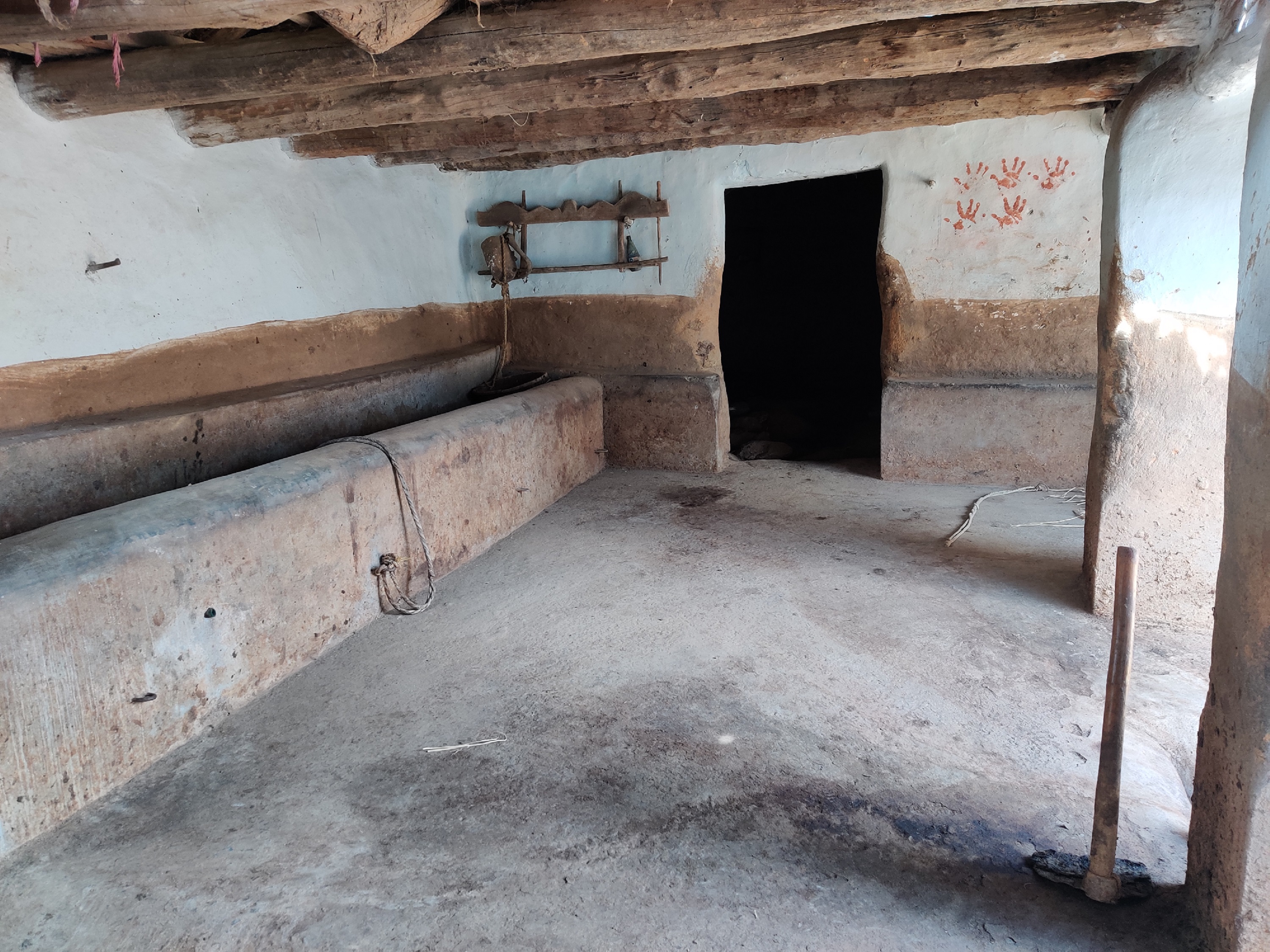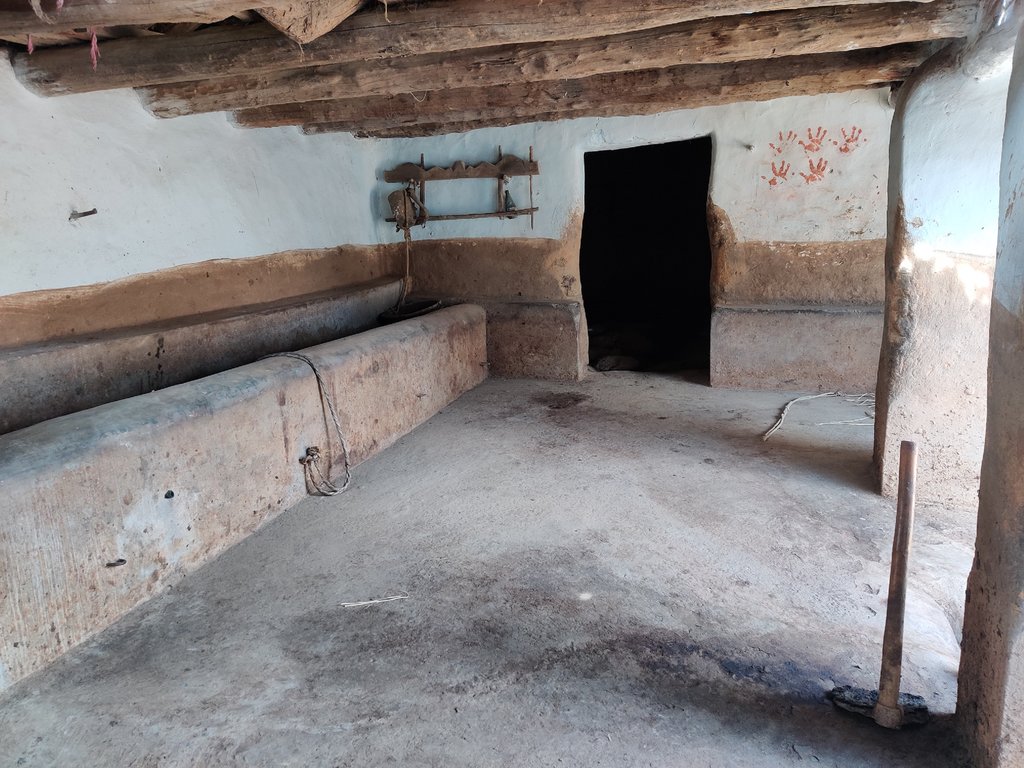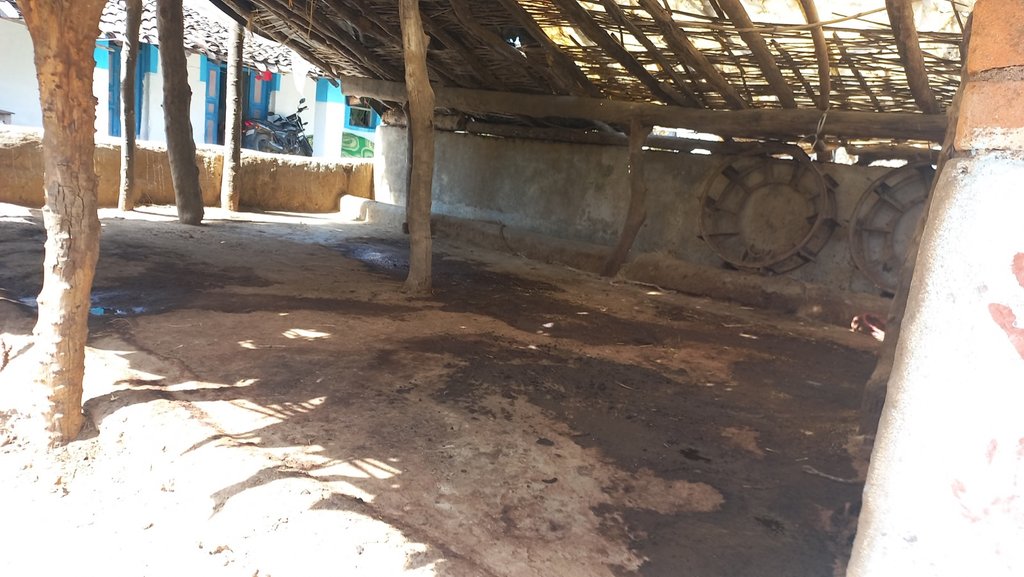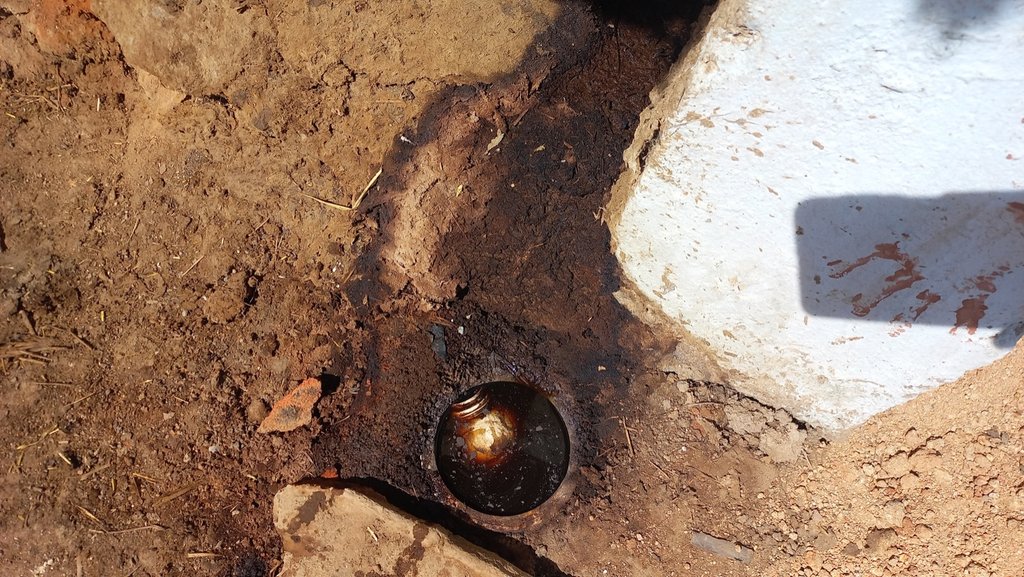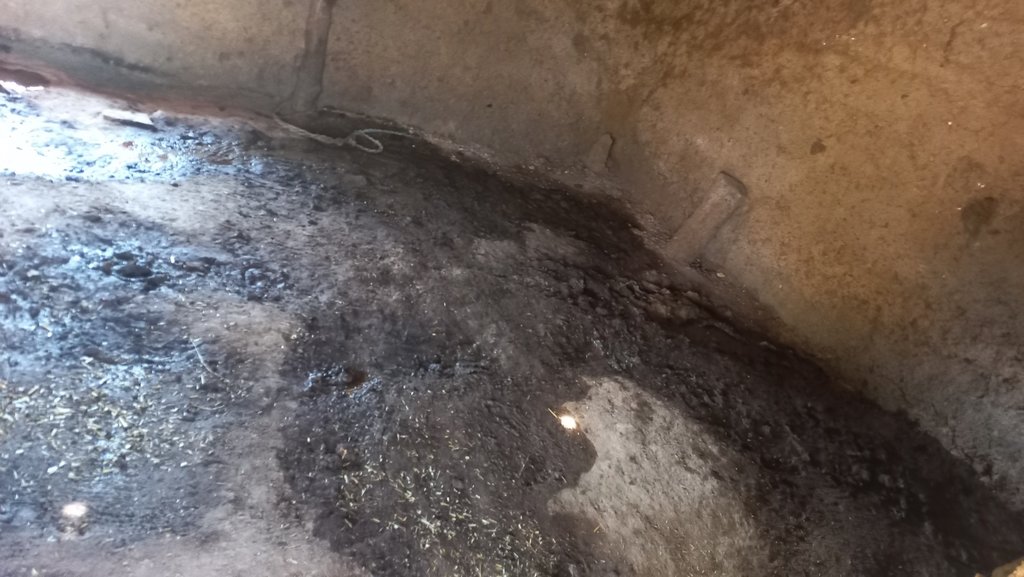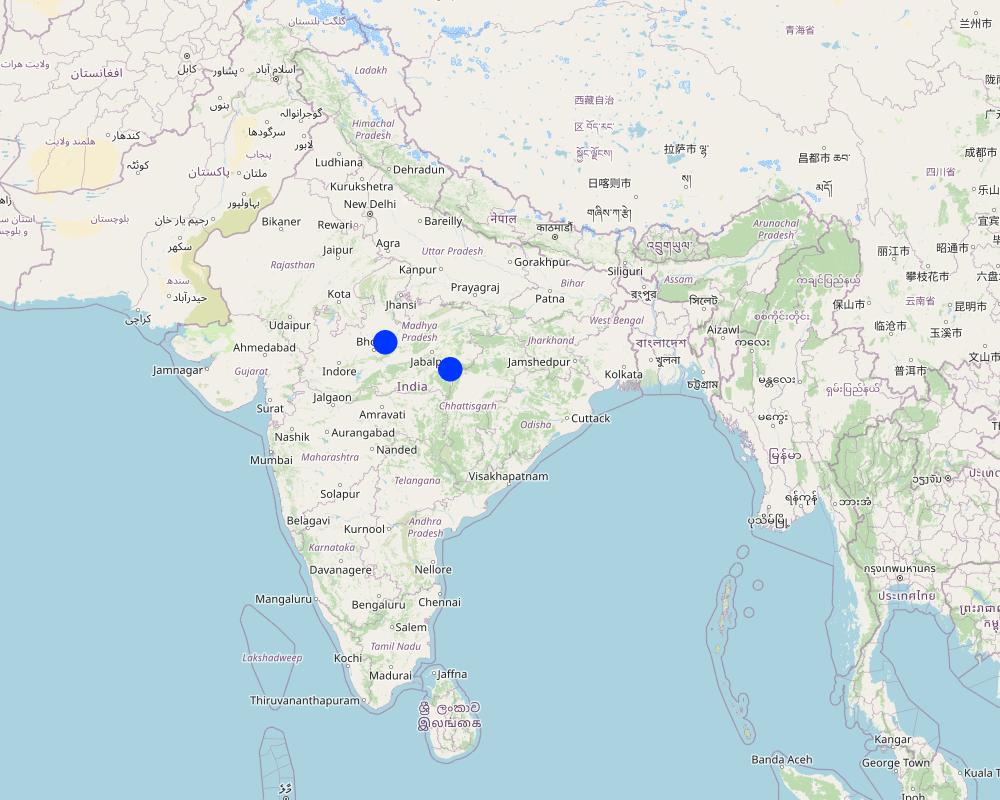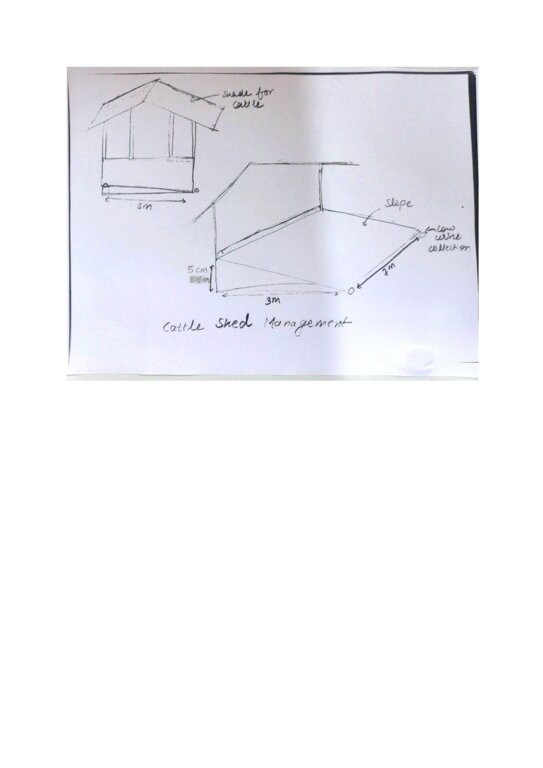Improved Cattle Shed Flooring for Conservation of Cow Dung and Urine for Biofertilizer Production at Farm Level [อินเดีย]
- ผู้สร้างสรรค์:
- การอัพเดท:
- ผู้รวบรวม: Santosh Gupta
- ผู้เรียบเรียง: Noel Templer, Stephanie Katsir, Kim Arora, Tabitha Nekesa, Ahmadou Gaye, Siagbé Golli
- ผู้ตรวจสอบ: Udo Höggel, Joana Eichenberger, Sally Bunning
technologies_6721 - อินเดีย
- บทสรุปทั้งหมดในรูปแบบของ PDF
- บทสรุปทั้งหมดในรูปแบบของ PDF เพื่อพิมพ์
- บทสรุปทั้งหมดในรูปหน้าเว็บ
- บทสรุปทั้งหมด (ไม่มีการจัดเรียง)
- Improved Cattle Shed Flooring for Conservation of Cow Dung and Urine for Biofertilizer Production at Farm Level: 25 มิถุนายน 2023 (inactive)
- Improved Cattle Shed Flooring for Conservation of Cow Dung and Urine for Biofertilizer Production at Farm Level: 14 กันยายน 2023 (inactive)
- Improved Cattle Shed Flooring for Conservation of Cow Dung and Urine for Biofertilizer Production at Farm Level: 11 เมษายน 2024 (public)
ดูส่วนย่อย
ขยายทั้งหมด ย่อทั้งหมด1. ข้อมูลทั่วไป
1.2 รายละเอียดที่ติดต่อได้ของผู้รวบรวมและองค์กรที่เกี่ยวข้องในการประเมินและการจัดเตรียมทำเอกสารของเทคโนโลยี
ชื่อของโครงการซึ่งอำนวยความสะดวกในการทำเอกสารหรือการประเมินเทคโนโลยี (ถ้าเกี่ยวข้อง)
Soil protection and rehabilitation for food security (ProSo(i)l)ชื่อขององค์กรซึ่งอำนวยความสะดวกในการทำเอกสารหรือการประเมินเทคโนโลยี (ถ้าเกี่ยวข้อง)
Deutsche Gesellschaft für Internationale Zusammenarbeit (GIZ) GmbH (GIZ) - เยอรมนีชื่อขององค์กรซึ่งอำนวยความสะดวกในการทำเอกสารหรือการประเมินเทคโนโลยี (ถ้าเกี่ยวข้อง)
Alliance Bioversity and International Center for Tropical Agriculture (Alliance Bioversity-CIAT) - เคนยาชื่อขององค์กรซึ่งอำนวยความสะดวกในการทำเอกสารหรือการประเมินเทคโนโลยี (ถ้าเกี่ยวข้อง)
Ecociate Consultants (Ecociate Consultants) - อินเดีย1.3 เงื่อนไขการใช้ข้อมูลที่ได้บันทึกผ่านทาง WOCAT
ผู้รวบรวมและวิทยากรหลักยอมรับเงื่อนไขเกี่ยวกับการใช้ข้อมูลที่ถูกบันทึกผ่านทาง WOCAT:
ใช่
1.4 การเปิดเผยเรื่องความยั่งยืนของเทคโนโลยีที่ได้อธิบายไว้
เทคโนโลยีที่ได้อธิบายไว้นี้เป็นปัญหาของความเสื่อมโทรมโทรมของที่ดินหรือไม่ จึงไม่ได้รับการยอมรับว่าเป็นเทคโนโลยีเพื่อการจัดการที่ดินอย่างยั่งยืน:
ไม่ใช่
2. การอธิบายลักษณะของเทคโนโลยี SLM
2.1 การอธิบายแบบสั้น ๆ ของเทคโนโลยี
คำจำกัดความของเทคโนโลยี:
In the cattle shed management system, the cattle shed should be constructed with an elevated concrete floor that slopes slightly toward a cow urine collection point. The collection point should be equipped with a drainage system to easily remove cow dung and urine.
An elevated concrete floor for cow dung and urine collection can improve hygiene, and waste management, and reduce labour costs in cattle sheds. Collected cow urine and cow dung can be used to prepare biological inputs and compost for nutrient and pest management in agriculture.
2.2 การอธิบายแบบละเอียดของเทคโนโลยี
คำอธิบาย:
Cattle shed management technology, including the use of a concrete elevated floor for cow dung and urine collection, is a cost-effective and efficient technology to support the natural farming system. This technology can be applied in both natural and human environments. In natural environments, such as rural or agricultural areas, cattle sheds are typically used for dairy and farmyard manure production. The use of this technology can improve the hygiene of cattle and their environment, reduce waste and pollution, and promote the sustainable use of natural resources. The cow dung and urine so collected can be used as fertilizer to improve soil quality, and the improved hygiene of the cattle can reduce the risk of diseases spreading to other animals or humans. The use of this technology can help to reduce the negative impacts of cattle farming on the surrounding environment, such as odours and pollution. It can also improve the hygiene of the cattle and their environment, which is important for both animal welfare and public health.
Traditionally farmers were constructing the floors of cattle sheds using mud and soil. These floors absorb the cow urine and the movement of animals also makes holes in it because of that cow urine and cow dung are used to get filled in these halls. Which made the entire floor unhygienic for both animals and farmers. Because of such surfaces, it was very hard to clean these sheds. The use of an elevated floor made with cement-concrete and a waste management system can help to keep the cattle shed clean and dry, which can reduce the risk of disease and infection among the animals. The collection and disposal of cow dung and urine can help preventing environmental pollution, reducing the negative impacts of cattle farming on the surrounding area, and promoting sustainable use of natural resources. The use of a concrete elevated floor can make cleaning the cattle shed faster and easier, reducing labour costs and improving the efficiency of the farming operation.
Technical specifications for the construction of cattle sheds can vary depending on factors such as the size of the herd, local environmental regulations, and available resources. However, in general, the main characteristics and elements of cattle shed management technology are designed to promote animal welfare, hygiene, waste management, and sustainability. Proper cattle shed management technology can provide a comfortable and safe environment for the animals, which can reduce stress and promote animal welfare. Proper waste management and ventilation can help to minimize unpleasant odours from the cattle shed, which thus reduces negative impacts on the surrounding community.
Establishing and maintaining cattle shed management technology requires a combination of technical expertise, labour, and resources. By investing in these inputs, farmers can promote sustainable and efficient cattle farming practices and improve the health and welfare of their animals.
The collected cow urine and cow dung are the main resources for preparing the biological inputs and different types of compost for meeting the nutritional requirement of crops while also addressing the challenges of pest and disease management in a natural or organic farming system. The improved flooring of cow shed units has been a great intervention to replace and reduce the usage of synthetic fertilisers and pesticides in the project region.
The views of land users, such as farmers or livestock keepers, about cattle shed management technology, including the use of a concrete elevated floor for cow dung and urine collection, can vary depending on their experiences and perceptions. The interviewed land user liked or appreciated, cattle shed management for improving animal health and productivity, increasing farm profitability, cleaning the cattle shed easier and faster, reducing labour costs, improving efficiency, and for environmental benefits.
2.3 รูปภาพของเทคโนโลยี
2.4 วีดีโอของเทคโนโลยี
ความคิดเห็น/อธิบายสั้นๆ:
https://youtube.com/watch?v=Gd6u8yZ9DqY&si=EnSIkaIECMiOmarE
วันที่:
01/02/2021
สถานที่:
Mandla, Madhya Pradesh, India
ชื่อผู้ถ่ายวีดีโอ:
Soil Matters
2.5 ประเทศภูมิภาค หรือสถานที่ตั้งที่เทคโนโลยีได้นำไปใช้และได้รับการครอบคลุมโดยการประเมินนี้
ประเทศ:
อินเดีย
ภูมิภาค/รัฐ/จังหวัด:
Madhya Pradesh
ข้อมูลจำเพาะเพิ่มเติมของสถานที่ตั้ง :
Mandla District
ระบุการกระจายตัวของเทคโนโลยี:
- ใช้ ณ จุดที่เฉพาะเจาะจงหรือเน้นไปยังบริเวณพื้นที่ขนาดเล็ก
Is/are the technology site(s) located in a permanently protected area?
ไม่ใช่
แสดงความคิดเห็น:
The technology is being adopted by more than 100 farmers across the 10-15 villages of the Bichhiya block in Mandla District of Madhya Pradesh
Map
×2.6 วันที่การดำเนินการ
ถ้าไม่รู้ปีที่แน่นอน ให้ระบุวันที่โดยประมาณ:
- น้อยกว่า 10 ปี (ไม่นานนี้)
2.7 คำแนะนำของเทคโนโลยี
ให้ระบุว่าเทคโนโลยีถูกแนะนำเข้ามาอย่างไร:
- ทางโครงการหรือจากภายนอก
ความคิดเห็น (ประเภทของโครงการ เป็นต้น) :
Initially, the project supported the farmers in the construction of cemented cow shed floors in a limited area. However, there has also been investment from the users either by putting extra funds to extend the area or by contributing labour.
3. การจัดประเภทของเทคโนโลยี SLM
3.1 วัตถุประสงค์หลักของเทคโนโลยี
- ปรับปรุงการผลิตให้ดีขึ้น
- ลด ป้องกัน ฟื้นฟู การเสื่อมโทรมของที่ดิน
- อนุรักษ์ระบบนิเวศน์
- สร้างผลกระทบทางด้านเศรษฐกิจที่เป็นประโยชน์
- Control cattle diseases
3.2 ประเภทของการใช้ที่ดินในปัจจุบันที่ได้นำเทคโนโลยีไปใช้
Land use mixed within the same land unit:
ไม่ใช่

พื้นที่ปลูกพืช
- การปลูกพืชล้มลุกอายุปีเดียว
Annual cropping - Specify crops:
- oilseed crops - sunflower, rapeseed, other
- cereals - wheat (winter)
- cereals - maize
- cereals - rice (wetland)
- legumes and pulses - lentils
- vegetables - leafy vegetables (salads, cabbage, spinach, other)
จำนวนของฤดูเพาะปลูกต่อปี:
- 2
ระบุ:
In kharif (summer) season farmers are sowing paddy in wetlands and in rabi (winter) season wheat, chickpea, mustard, maize and other vegetables
Is intercropping practiced?
ใช่
If yes, specify which crops are intercropped:
Chickpea intercropping with beans, mixed cropping system of vegetables present
Is crop rotation practiced?
ใช่
ถ้าใช่ ระบุ:
Rice- Chickpea
Rice-Wheat
Rice- Maize
แสดงความคิดเห็น:
The intervention is mostly focused on improved cattle shed units. However, collected cow urine and cow dung are good for restoring the degraded agricultural land.
3.3 Has land use changed due to the implementation of the Technology?
Has land use changed due to the implementation of the Technology?
- No (Continue with question 3.4)
3.4 การใช้น้ำ
การใช้น้ำของที่ดินที่มีการใช้เทคโนโลยีอยู่:
- น้ำฝนร่วมกับการชลประทาน
แสดงความคิดเห็น:
For irrigation, most of the farmers were dependent upon rain in the Kharif and Rabi season. Some of the farmers were using additional irrigation during critical crop stages by using water canals.
3.5 กลุ่ม SLM ที่ตรงกับเทคโนโลยีนี้
- การจัดการปลูกพืชร่วมกับปศุสัตว์
- การจัดการความอุดมสมบรูณ์ของดินแบบผสมผสาน
3.6 มาตรการ SLM ที่ประกอบกันเป็นเทคโนโลยี

มาตรการจัดการพืช
- A2: อินทรียวัตถุในดิน/ความอุดมสมบูรณ์ในดิน
- A6: Residue management
A6: Specify residue management:
A 6.4: retained

มาตรการอนุรักษ์ด้วยโครงสร้าง
- S9: ที่พักพิงสำหรับพืชและสัตว์

มาตรการอนุรักษ์ด้วยการจัดการ
- M6: การจัดการของเสีย (การทำ รีไซเคิล การเอากลับมาใช้ใหม่หรือการลดปริมาณ)
แสดงความคิดเห็น:
The implemented technology led to the management and use of waste for productive purposes. While it has improved the productivity of animals by reducing the occurrence of diseases, it has also enabled the preparation of organic inputs to replace the synthetic fertilisers in farming.
3.7 รูปแบบหลักของการเสื่อมโทรมของที่ดินที่ได้รับการแก้ไขโดยเทคโนโลยี

การเสื่อมโทรมของดินทางด้านเคมี
- Cn (Fertility decline): ความอุดมสมบูรณ์และปริมาณอินทรียวัตถุในดินถูกทำให้ลดลงไป (ไม่ได้เกิดจากสาเหตุการกัดกร่อน)

การเสื่อมโทรมของดินทางด้านชีวภาพ
- Bp (Increase of pests/diseases): การเพิ่มขึ้นของศัตรูพืชและโรคพืช

การเสื่อมโทรมของน้ำ
- Hp (Decline of surface water quality): การลดลงของคุณภาพน้ำที่ผิวดิน
- Hq (Decline of groundwater quality): การลดลงของคุณภาพน้ำบาดาล
แสดงความคิดเห็น:
Proper collection of cow dung and cow urine minimised run-off these substance and mixing with surface water used for various purposes including drinking water.
3.8 การป้องกัน การลดลง หรือการฟื้นฟูความเสื่อมโทรมของที่ดิน
ระบุเป้าหมายของเทคโนโลยีกับความเสื่อมโทรมของที่ดิน:
- ป้องกันความเสื่อมโทรมของที่ดิน
- ลดความเสื่อมโทรมของดิน
แสดงความคิดเห็น:
Application of cow urine and cow dung in soil by mixing with other organic matters improves the soil health and also reduces the dependency on synthetic fertilisers and pesticides
4. ข้อมูลจำเพาะด้านเทคนิค กิจกรรมการนำไปปฏิบัติใช้ ปัจจัยนำเข้า และค่าใช้จ่าย
4.1 แบบแปลนทางเทคนิคของเทคโนโลยี
ข้อมูลจำเพาะด้านเทคนิค (แบบแปลนทางเทคนิคของเทคโนโลยี):
Dimensions of the cowshed (depending on the number of cows kept):
Length: 7m
Width: 3m
Elevated: 5 cm (means in effect the slope: i.e. the front floor of the cowshed is 5 cm higher than the floor at the end, where dung and urine get collected)
ผู้เขียน:
Payal Dewangan
วันที่:
22/02/2023
4.2 ข้อมูลทั่วไปเกี่ยวกับการคำนวณปัจจัยนำเข้าและค่าใช้จ่าย
ให้ระบุว่าค่าใช้จ่ายและปัจจัยนำเข้าได้รับการคำนวณอย่างไร:
- ต่อหน่วยเทคโนโลยี
โปรดระบุหน่วย:
one cattle shed
Specify dimensions of unit (if relevant):
meter
อื่นๆ หรือสกุลเงินประจำชาติ (ระบุ):
Indian Rupee
If relevant, indicate exchange rate from USD to local currency (e.g. 1 USD = 79.9 Brazilian Real): 1 USD =:
82.24
ระบุค่าเฉลี่ยของค่าจ้างในการจ้างแรงงานต่อวัน:
240
4.3 กิจกรรมเพื่อการจัดตั้ง
| กิจกรรม | Timing (season) | |
|---|---|---|
| 1. | Concrete floor construction for cattle shed | March |
| 2. | Cattle shed roof development | April |
4.4 ค่าใช้จ่ายของปัจจัยนำเข้าที่จำเป็นสำหรับการจัดตั้ง
If you are unable to break down the costs in the table above, give an estimation of the total costs of establishing the Technology:
28000.0
ถ้าผู้ใช้ที่ดินรับภาระน้อยกว่า 100% ของค่าใช้จ่าย ให้ระบุว่าใครเป็นผู้รับผิดชอบส่วนที่เหลือ:
Gram Paryavaran Samiti and Prakritik Sansadhan Prabhandhan Samiti
แสดงความคิดเห็น:
Village groups were formed for the implementation of the technology
4.5 การบำรุงรักษาสภาพหรือกิจกรรมที่เกิดขึ้นเป็นประจำ
| กิจกรรม | ช่วงระยะเวลา/ความถี่ | |
|---|---|---|
| 1. | Cleaning of concrete floor | Once in a day |
| 2. | Collection of cow dung | Once in a day |
| 3. | collection of cow urine from the pit or drum | Twice in a week |
| 4. | Fodder and drinking water provision | Twice in a day |
4.7 ปัจจัยสำคัญที่สุดที่มีผลกระทบต่อค่าใช้จ่าย
ปัจจัยสำคัญที่สุดที่มีผลกระทบต่อค่าใช้จ่ายต่างๆ:
Design and technical specifications: The cost of the technology can vary depending on the design and technical specifications of the cattle shed, including the size and materials used.
Construction materials and labor costs: The cost of construction materials and labor can vary depending on local market conditions and availability.
Location: The cost of transporting materials and labor to the construction site can vary depending on the location of the farm.
Maintenance and repair costs: The cost of maintaining and repairing the cattle shed can also add to the overall cost of the technology.
Training and capacity building: Providing training and capacity building to farmers and workers on proper cattle shed management techniques can add to the overall cost of the technology.
5. สิ่งแวดล้อมทางธรรมชาติและของมนุษย์
5.1 ภูมิอากาศ
ฝนประจำปี
- < 250 ม.ม.
- 251-500 ม.ม.
- 501-750 ม.ม.
- 751-1,000 ม.ม.
- 1,001-1,500 ม.ม.
- 1,501-2,000 ม.ม.
- 2,001-3,000 ม.ม.
- 3,001-4,000 ม.ม.
- > 4,000 ม.ม.
ระบุปริมาณน้ำฝนเฉลี่ยรายปี (ถ้ารู้) :หน่วย ม.ม.
1427.00
ข้อมูลจำเพาะ/ความคิดเห็นเรื่องปริมาณน้ำฝน:
Highest rainfall occurs between June to September.
ระบุชื่อของสถานีตรวดวัดอากาศที่ใช้อ้างอิงคือ:
Mandla, Madhya Pradesh
เขตภูมิอากาศเกษตร
- กึ่งแห้งแล้ง
The climate of the District is tropical, with moderate winters, severe summers, and well-distributed rainfall received from the southwest monsoon. However, due to higher general elevation and abundance of forests, summer temperatures do not rise as much as in other areas.
5.2 สภาพภูมิประเทศ
ค่าเฉลี่ยความลาดชัน:
- ราบเรียบ (0-2%)
- ลาดที่ไม่ชัน (3-5%)
- ปานกลาง (6-10%)
- เป็นลูกคลื่น (11-15%)
- เป็นเนิน (16-30%)
- ชัน (31-60%)
- ชันมาก (>60%)
ธรณีสัณฐาน:
- ที่ราบสูง/ที่ราบ
- สันเขา
- ไหล่เขา
- ไหล่เนินเขา
- ตีนเนิน
- หุบเขา
ระดับความสูง:
- 0-100 เมตร
- 101-500 เมตร
- 501-1,000 เมตร
- 1,001-1,500 เมตร
- 1,501-2,000 เมตร
- 2,001-2,500 เมตร
- 2,501-3,000 เมตร
- 3,001-4,000 เมตร
- > 4,000 เมตร
ให้ระบุถ้าเทคโนโลยีได้ถูกนำไปใช้:
- ไม่เกี่ยวข้อง
ความคิดเห็นและข้อมูลจำเพาะเพิ่มเติมเรื่องสภาพภูมิประเทศ:
The topography of the project area consists of a hilly area and a forest area. Mandla District is hilly and forested (Satpura hill range) and highly undulating with a narrow strip of cultivated plains in the valley portion of the river. The plateau is in the northern part formed by basalt, and east-west trending hills in the southern part. The highest elevation is 934 m amsl in the northern part, and the lowest is around 400 m amsl in the northwestern part of the area. The elevation of the studied block Bichhiya is 453 m amsl.
Source: District at a Glance; Ministry of Water Resources, Government of Madhya Pradesh
5.3 ดิน
ค่าเฉลี่ยความลึกของดิน:
- ตื้นมาก (0-20 ซ.ม.)
- ตื้น (21-50 ซ.ม.)
- ลึกปานกลาง (51-80 ซ.ม.)
- ลึก (81-120 ซ.ม.)
- ลึกมาก (>120 ซ.ม.)
เนื้อดิน (ดินชั้นบน):
- หยาบ/เบา (ดินทราย)
- ปานกลาง (ดินร่วน ทรายแป้ง)
เนื้อดินล่าง (> 20 ซ.ม.ต่ำจากผิวดิน):
- ปานกลาง (ดินร่วน ทรายแป้ง)
อินทรียวัตถุในดิน:
- ต่ำ (<1%)
(ถ้ามี) ให้แนบคำอธิบายเรื่องดินแบบเต็มหรือระบุข้อมูลที่มีอยู่ เช่น ชนิดของดิน ค่า pH ของดินหรือความเป็นกรดของดิน ความสามารถในการแลกเปลี่ยนประจุบวก ไนโตรเจน ความเค็ม เป็นต้น:
Soil Testing Parameter status (Average) 2017-20 for the project areas is as follows. This data is based on the soil samples tested by the FES in its soil labs from the project villages.
Sail pH:-5.906548628; EC (electrical conductivity): 0.122993577: Soil Organic Carbon: 0:83%; Nitrogen:- 293.3696598; Phosphorus:- 25.77762582; Potassium (K):- 139.6696636: Sulphur
(S)-18.93457993; Zinc (Zn):-0.955246706; Boron (Bn):-0.490850376
5.4 ความเป็นประโยชน์และคุณภาพของน้ำ
ระดับน้ำใต้ดิน:
> 50 เมตร
น้ำไหลบ่าที่ผิวดิน:
ปานกลาง
คุณภาพน้ำ (ที่ยังไม่ได้บำบัด):
เป็นน้ำเพื่อการดื่มที่ไม่ดี (จำเป็นต้องได้รับการบำบัด)
Water quality refers to:
both ground and surface water
ความเค็มของน้ำเป็นปัญหาหรือไม่:
ไม่ใช่
กำลังเกิดน้ำท่วมในพื้นที่หรือไม่:
ไม่ใช่
ความคิดเห็นและข้อมูลจำเพาะเพิ่มเติมเรื่องคุณภาพและปริมาณน้ำ:
The groundwater status is within the safe limits as per the reports by the Government of Madhya Pradesh. People use water from rivers, streams, and traditional small wells for domestic purposes. In the absence of good vegetative cover, the rainwater washes off the fertile topsoil from the farmlands making the land barren and resulting in the siltation of ponds and other water bodies. Further, a heavy infestation of invasive species such as Lantana Camara compounds the degradation.
The studied block Bichhiya is in a better position in terms of stage of groundwater development with 17%, stage of groundwater development refers to the % of groundwater being used for various purposes from the available groundwater in that area e.g. net annual groundwater availability in Bichhiya block is 9087 ham (hectare meters) while the existing annual groundwater draft for all usage is 1523 ham, making it a 17% groundwater development stage, while the district average is 79%.
Source: http://cgwb.gov.in/District Profile/MP/Mandla.pdf
5.5 ความหลากหลายทางชีวภาพ
ความหลากหลายทางชนิดพันธุ์:
- สูง
ความหลากหลายของแหล่งที่อยู่:
- สูง
ความคิดเห็นและข้อมูลจำเพาะเพิ่มเติมของความหลากหลายทางชีวภาพ:
The cattle shed management unit or center is present nearby the forest area of Kanha National Park. There is high biodiversity present in the technology implementation area. Ecological assessment report in Mandla (where this Technology is applied) showed improved biodiversity on common lands under village governance compared to open-access or commons under government ownership. On average, the Shannon Diversity Index of managed common lands was 1.45 compared to 0.42 for the open access of ungoverned commons. Most of the sites under open access lands are infested by Lantana Camara, which is the main reason for the lower biomass and diversity of the ungoverned lands.
5.6 ลักษณะของผู้ใช้ที่ดินที่นำเทคโนโลยีไปปฏิบัติใช้
อยู่กับที่หรือเร่ร่อน:
- อยู่กับที่
แนวทางการตลาดของระบบการผลิต:
- mixed (subsistence/ commercial)
รายได้ที่มาจากนอกฟาร์ม:
- > 50% ของรายได้ทั้งหมด
ระดับของความมั่งคั่งโดยเปรียบเทียบ:
- จน
เป็นรายบุคคล/ครัวเรือน:
- กลุ่ม/ชุมชน
ระดับของการใช้เครื่องจักรกล:
- งานที่ใช้แรงกาย
- การใช้กำลังจากสัตว์
เพศ:
- หญิง
- ชาย
อายุของผู้ใช้ที่ดิน:
- ผู้เยาว์
- วัยกลางคน
5.7 Average area of land used by land users applying the Technology
- < 0.5 เฮกตาร์
- 0.5-1 เฮกตาร์
- 1-2 เฮกตาร์
- 2-5 เฮกตาร์
- 5-15 เฮกตาร์
- 15-50 เฮกตาร์
- 50-100 เฮกตาร์
- 100-500 เฮกตาร์
- 500-1,000 เฮกตาร์
- 1,000-10,000 เฮกตาร์
- >10,000 เฮกตาร์
พิจารณาว่าเป็นขนาดเล็ก กลาง หรือขนาดใหญ่ (ซึ่งอ้างอิงถึงบริบทระดับท้องถิ่น):
- ขนาดเล็ก
5.8 กรรมสิทธิ์ในที่ดิน สิทธิในการใช้ที่ดินและสิทธิในการใช้น้ำ
กรรมสิทธิ์ในที่ดิน:
- รายบุคคล ได้รับสิทธิครอบครอง
สิทธิในการใช้ที่ดิน:
- รายบุคคล
สิทธิในการใช้น้ำ:
- เกี่ยวกับชุมชน (ถูกจัดระเบียบ)
- รายบุคคล
Are land use rights based on a traditional legal system?
ใช่
ระบุ:
Some of the land parcels are ancestral land units while some have been transferred into private ownership by the State Government over the years
5.9 การเข้าถึงบริการและโครงสร้างพื้นฐาน
สุขภาพ:
- จน
- ปานกลาง
- ดี
การศึกษา:
- จน
- ปานกลาง
- ดี
ความช่วยเหลือทางด้านเทคนิค:
- จน
- ปานกลาง
- ดี
การจ้างงาน (เช่น ภายนอกฟาร์ม):
- จน
- ปานกลาง
- ดี
ตลาด:
- จน
- ปานกลาง
- ดี
พลังงาน:
- จน
- ปานกลาง
- ดี
ถนนและการขนส่ง:
- จน
- ปานกลาง
- ดี
น้ำดื่มและการสุขาภิบาล:
- จน
- ปานกลาง
- ดี
บริการด้านการเงิน:
- จน
- ปานกลาง
- ดี
6. ผลกระทบและสรุปคำบอกกล่าว
6.1 ผลกระทบในพื้นที่ดำเนินการ (On-site) จากการใช้เทคโนโลยี
ผลกระทบทางด้านเศรษฐกิจและสังคม
การผลิต
การผลิตพืชผล
แสดงความคิดเห็น/ระบุ:
It was observed and noted from the field site that instead of using chemicals, the application of cow urine and cow dung in the form of farm yard manure has helped in improved production as it led to the reduction of pest infestation and better nutrient uptake from the soil.
คุณภาพพืชผล
แสดงความคิดเห็น/ระบุ:
Reduction in the use of chemicals in the field and application of collected cow urine and other bioresource products made from cow dung helped in improving the quality of crop in terms of harder crops, good weight of grain, test etc.
การผลิตสัตว์
แสดงความคิดเห็น/ระบุ:
The improved cattle shed played a crucial role in maintaining the hygiene of animal sheds, which led to the lesser occurrence of disease among animals. Also, the stress level of animals due to the presence of insects and flies reduced significantly. A combination of all these factors improved the milk yield.
การเสี่ยงต่อความล้มเหลวในการผลิต
แสดงความคิดเห็น/ระบุ:
Using sustainable methods for crop production by application of bio inputs not only helps in increasing soil fertility but also contributes to increasing crop resistance, pest control, and better crop development.
ความหลากหลายของผลิตภัณฑ์
รายได้และค่าใช้จ่าย
ค่าใช่จ่ายของปัจจัยการผลิตทางการเกษตร
แสดงความคิดเห็น/ระบุ:
Reduced to some extent as now farmers can make their own bio-inputs using the cow urine and cow dung collected from the cattle shed
รายได้จากฟาร์ม
แสดงความคิดเห็น/ระบุ:
A combination of improved productivity, reduced cost towards agriculture inputs and better milk productivity has helped farmers in improving their income.
ความหลากหลายของแหล่งผลิตรายได้
แสดงความคิดเห็น/ระบุ:
Some of the farmers have initiated their own bio resource centres to sell cow urine and cow dung-based bio-inputs, vermicompost etc.
ภาระงาน
แสดงความคิดเห็น/ระบุ:
The workload of women members in the household was reduced very significantly due to covering the mud-based cow floor with cement-concrete-based cow floor, earlier cleaning of the cow dung and cow urine used to take a lot of the time. However with new floor, it can be cleaned in less than 5 minutes saving almost an hour in a day.
ผลกระทบด้านสังคมวัฒนธรรมอื่น ๆ
ความมั่นคงด้านอาหาร / พึ่งตนเองได้
สถานการณ์ด้านสุขภาพ
แสดงความคิดเห็น/ระบุ:
Improved hygiene is good for both animal and human health
โอกาสทางวัฒนธรรม
สถาบันของชุมชน
ผลกระทบด้านนิเวศวิทยา
ดิน
ความชื้นในดิน
แสดงความคิดเห็น/ระบุ:
Application of cow dung, compost and other bio-inputs have improved the soil moisture
การหมุนเวียนและการเติมของธาตุอาหาร
แสดงความคิดเห็น/ระบุ:
Application of cow dung, compost and other bio-inputs will help in improving the nutrient cycling in the soil and will enhance the soil microbial activities
ลดความเสี่ยงของภัยพิบัติ
การปล่อยคาร์บอนและก๊าซเรือนกระจก
แสดงความคิดเห็น/ระบุ:
Some of the farmers are using the collected cow dung as an input for their 'Bio-gas' plants. Thus, the use of biogas plants not only reduces the use of fire wood and LPG for cooking but its waste (slurry) is also used as inputs for agriculture fields. Thus reducing the overall footprint of GHG emission.
6.2 ผลกระทบนอกพื้นที่ดำเนินการ (Off-site) จากการใช้เทคโนโลยี
ความเสียหายต่อพื้นที่เพาะปลูกของเพื่อนบ้าน
ผลกระทบของก๊าซเรือนกระจก
แสดงความคิดเห็น/ระบุ:
Some of the farmers have installed bio gas plants. Use of biogas plants not only reduces the use of fire wood and LPG for cooking but its waste (slurry) is also used as inputs for Some of the farmers are using the collected cow dung as an input for their 'Bio-gas' plants agriculture fields. Thus reducing the overall footprint of GHG emission.
Also the improved floor have helped in proper collection of cow dung and cow urine for the purpose of composting. Composting makes the compounds in manure more stable and therefore reduces the amount that is released into the atmosphere.
6.3 การเผชิญและความตอบสนองของเทคโนโลยีต่อการเปลี่ยนแปลงสภาพภูมิอากาศที่ค่อยเป็นค่อยไป และสภาพรุนแรงของภูมิอากาศ / ภัยพิบัติ (ที่รับรู้ได้โดยผู้ใช้ที่ดิน)
การเปลี่ยนแปลงสภาพภูมิอากาศที่ค่อยเป็นค่อยไป
การเปลี่ยนแปลงสภาพภูมิอากาศที่ค่อยเป็นค่อยไป
| ฤดู | increase or decrease | เทคโนโลยีมีวิธีการรับมืออย่างไร | |
|---|---|---|---|
| อุณหภูมิประจำปี | เพิ่มขึ้น | ดีมาก |
6.4 การวิเคราะห์ค่าใช้จ่ายและผลประโยชน์ที่ได้รับ
ผลประโยชน์ที่ได้รับเปรียบเทียบกับค่าใช้จ่ายในการจัดตั้งเป็นอย่างไร (จากมุมมองของผู้ใช้ที่ดิน)
ผลตอบแทนระยะสั้น:
ด้านลบ
ผลตอบแทนระยะยาว:
ด้านบวก
ผลประโยชน์ที่ได้รับเปรียบเทียบกับค่าใช้จ่ายในการบำรุงรักษาหรือต้นทุนที่เกิดขึ้นซ้ำอีก เป็นอย่างไร (จากมุมมองของผู้ใช้ที่ดิน)
ผลตอบแทนระยะสั้น:
ด้านลบเล็กน้อย
ผลตอบแทนระยะยาว:
ด้านบวกอย่างมาก
แสดงความคิดเห็น:
Low maintenance cost compared with benefits of higher animal productivity and hygienic living
6.5 การปรับตัวของเทคโนโลยี
- 1-10%
Of all those who have adopted the Technology, how many did so spontaneously, i.e. without receiving any material incentives/ payments?
- 0-10%
6.6 การปรับตัว
เทคโนโลยีได้รับการปรับเปลี่ยนเมื่อเร็วๆนี้ เพื่อให้ปรับตัวเข้ากับสภาพที่กำลังเปลี่ยนแปลงหรือไม่:
ไม่ใช่
6.7 จุดแข็ง / ข้อได้เปรียบ / โอกาสของเทคโนโลยี
| จุดแข็ง / ข้อได้เปรียบ / โอกาสในทัศนคติของผู้ใช้ที่ดิน |
|---|
| Reduced labour of urine and dung collection |
| Better animal management |
| จุดแข็ง / ข้อได้เปรียบ / โอกาสในทัศนคติของผู้รวบรวมหรือวิทยากรหลัก |
|---|
| Reduced GHG emission because of better handling of dung and urine |
| Increased productivity because of the use of animal manure |
6.8 จุดอ่อน / ข้อเสียเปรียบ / ความเสี่ยงของเทคโนโลยีและวิธีการแก้ไข
| จุดอ่อน / ข้อเสียเปรียบ / ความเสี่ยงในทัศนคติของผู้ใช้ที่ดิน | มีวิธีการแก้ไขได้อย่างไร |
|---|---|
| High establishment cost | Subsidies and grants |
| Regular maintenance cost | Technological innovation |
| จุดอ่อน / ข้อเสียเปรียบ / ความเสี่ยงในทัศนคติของผู้รวบรวมหรือวิทยากรหลัก | มีวิธีการแก้ไขได้อย่างไร |
|---|---|
| Possibilities of disadoption because of maintenance cost | Increase returns of the units by extending new products from Urine and dung |
| No demand | Increase communication and extension on the benefits of different products from animals |
7. การอ้างอิงและการเชื่อมต่อ
7.1 วิธีการและแหล่งข้อมูล
- การสัมภาษณ์กับผู้ใช้ที่ดิน
7.2 การอ้างอิงถึงสิ่งตีพิมพ์
หัวข้อ, ผู้เขียน, ปี, หมายเลข ISBN:
Repairing cattle shed floor
ชื่อเรื่อง ผู้เขียน ปี ISBN:
Foundation for Ecological Security, Mandla, MP, India
7.3 Links to relevant online information
ชื่อเรื่องหรือคำอธิบาย:
Cattle sheds: one intervention, several benefits for farmers
URL:
https://www.youtube.com/watch?v=Gd6u8yZ9DqY
ลิงก์และโมดูล
ขยายทั้งหมด ย่อทั้งหมดลิงก์
ไม่มีลิงก์
โมดูล
ไม่มีโมดูล


